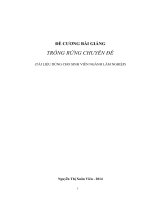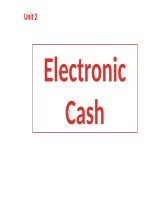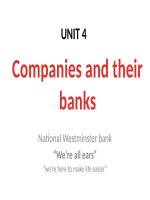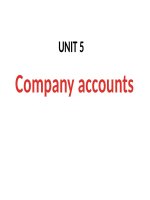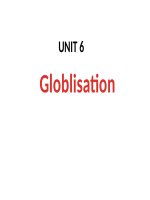unit 5 Bài giảng Anh văn chuyên ngành Tài chính Thư Viện Tài Liệu Tổng Hợp Com UNIT 5
Bạn đang xem bản rút gọn của tài liệu. Xem và tải ngay bản đầy đủ của tài liệu tại đây (142.67 KB, 9 trang )
5
AIMS:
Central banking
To learn about: the functions of central banks; monetary policy; key
vocabulary of central banking and monetary policy
To learn: how to say decimal numbers
To practise: talking about central banking decisions and policies
Lead in
o What are the functions of a central bank?
o How can the actions of a central bank affect individuals as well as companies?
Discussion
Which of the following would you expect a central bank to do? Mark them A= always,
S= sometimes, or N= never.
1. act as banker to the government and the commercial banks
2. attempt to influence the exchange rate
3. clear cheques between commercial banks
4. decide the country's minimum interest rate
5. decide all of a country's interest rates
6. issue banknotes
7. issue securities for companies
8. issue securities for the government
9. keep minimum deposits of commercial banks' reserves
10. lend money to banks in difficulty
11. lend money to small businesses
12. maintain financial stability
13. manage reserves of gold and foreign currencies
14. manage the assets of wealthy individuals
15. publish monetary and banking statistics
16. supervise the banking system
Unit 5: Central Banking
41
Vocabulary
You are going to read about the major functions of the Bank of England. Before you read,
check your understanding of the words (1-9) below by matching them with their definitions
(a-i).
1. policy
a. a level or situation which you intend to achieve
2. threats
b. a general, continuous increase in prices
3. oversight
c. an agreed plan of what to do
4. target
d. basic and most important
5. core [adjective]
e. in good condition
6. sound [adjective]
f. paid
7. sterling
g. potential sources of danger
8. inflation
h. supervision
9. remunerated
i. the name of the British currency
Reading 1: The Bank of England
1.A student has made notes during a lecture about the role of the Bank of England. Read
them quickly and decide which of the functions listed in the Discussion activity opposite
are included in the Bank of England's work, and which are not mentioned.
The Bank of England has two (1) ……………purposes. One is ensuring monetary stability,
i.e. having stable prices - low (2) ……………… - and consequently confidence in the currency.
The government sets an inflation (3) ……………… , and the Bank's Monetary Policy
Committee tries to meet it by raising or lowering the official interest rate when necessary.
UK banks and building societies have to hold reserves at the Bank. These are (4)……………
at the Bank's official interest rate. If British banks need to borrow short-term funds they do this
in the (5) …………… money markets.
The Bank can influence the amount of money and the interest rates in these markets - this is
how it implements its monetary (6) ………………
The Bank also deals in the foreign exchange market. It can use the UK's foreign currency and
gold reserves to try to influence the exchange rate if needed.
The Bank's other core purpose is to maintain the stability of the financial system. The Bank
has to detect and reduce any (7) ……………… to financial stability, and make sure the overall
Unit 5: Central Banking
42
system is safe and secure. It monitors and analyses the behaviour of the major participants in the
financial system and the wider financial and economic environment, and tries to identify
potential risks. A (8) ……………... and stable financial system is important, and is also
necessary for carrying out monetary policy efficiently.
The Bank's role also includes (9) ……………. of payment systems for transactions between
individuals, businesses and financial institutions.
The Bank sometimes acts as 'lender of last resort' to financial institutions in difficulty, to
prevent panic or a loss of confidence spreading through the whole financial system.
2.Complete the text with the words (1-9) from the Vocabulary exercise opposite.
3.According to the text, are the following statements true or false?
a. The Bank of England wants to prevent prices rising.
b. The government sets a figure for what it thinks should be the maximum inflation rate.
c. The government makes decisions about interest rates.
d. Commercial banks have to keep some of their funds at the Bank of England.
e. The Bank does not pay interest on commercial banks' deposits.
f. The Bank can try to change the sterling exchange rate.
g. The Bank has to eliminate threats to financial stability.
h. The Bank supervises the clearing system: the settlement of claims between banks.
i. The Bank always lends money to financial institutions in danger of going bankrupt.
4.Use a word or phrase from each box to make word combinations from the text. You can
use some words more than once. Then use the correct form of some of the word
combinations to complete the sentences below.
identify
exchange rates
implement
policies
influence
risks
maintain
stability
reduce
threats
a. Just like the central bank, all companies have to try to ………….potential financial
…………
b. The Bank can spend the country's currency reserves in order to …………………
Unit 5: Central Banking
43
c. The Bank can try to ……………… to the financial system, but it can't eliminate them
completely.
d. The Bank has to ……………the ………………of the financial system, but that doesn't mean
it rescues irresponsible banks.
e. The Bank …………………… that should enable it to meet the inflation target set by the
government.
Reading 2: Monetary policy
1. You are going to listen to read a passage about the monetary policy. Answer the
questions below.
At the Bank of England, in common with most central banks round the world now, when we
look at monetary policy, it involves changing interest rates.
The aim of monetary policy is to keep inflation low and stable. When you're setting interest
rates, what you're trying to do is to keep demand in the economy, what people consume, how
much they invest, in line with the long-term ability of an economy to supply goods and services
through labour, through people employed, and through the capital employed, machinery, plant
and equipment in the economy.
When interest rates rise, this will mean that individuals will tend to save more and consume
less. Also for companies, investment decisions are more expensive and that means that demand
will tend to be reduced. When interest rates are cut, the opposite happens – people will spend
rather than save and companies have more of an incentive to invest, and that means that the level
of demand rises. And it's by trying to set demand, to keep demand in line with supply in future,
so that the central bank is always looking ahead.
When the central bank sets the base rate for lending to commercial banks, it affects the whole
structure of interest rates in a country. For example, in the United Kingdom one of the things it
affects very quickly is the rate at which the banks and other organizations lend to households for
their mortgages, but of course it will also affect the rates at which companies borrow. Of course
that just means that the central bank controls the short-term interest rate. What happens to other
interest rates, one-year, five-year, ten-year interest rates, can be quite different.
1. What is the aim of monetary policy?
………………………………………………………………………………………………..
2. What tools does a central bank use to control supply and demand for money?
………………………………………………………………………………………………..
Unit 5: Central Banking
44
3. What tends to happen when interest rates rise?
………………………………………………………………………………………………..
4. What tends to happen when interest rates fall?
………………………………………………………………………………………………..
5. What do commercial banks do after the central bank changes the base rate at which it lends
them money?
………………………………………………………………………………………………..
2. Check your understanding of the language uses by matching the words in the box
with their definitions (1-8).
base rate
consume
incentive
plant
capital
demand
labour
supply
1. encouragement or a reason to do something
2. factories, and the machines and equipment in them
3. money invested in companies, to buy buildings, machinery, etc.
4. the quantity of goods and services offered for sale by companies
5. the rate at which the central bank lends money to commercial banks
6. to spend money on goods and services
7. what people consume and how much they invest
8. work done by people employed by businesses
Discussion
Go back to the first Discussion exercise. According to what you have learnt from the Reading
exercises, which of the 16 activities listed are done by central banks?
Language focus
Talking about figures 2
When discussing interest rates and monetary policy, you need to know how to say decimal
numbers.
English uses a symbol like a full stop between the two parts of a decimal number. It is called a
decimal point. A comma is not used in this position. In a pure number (without a unit of
measurement), each digit after the decimal point is said separately.
Unit 5: Central Banking
45
Examples:
3.5
three point five
3.51
three point five one (not three point fifty-one)
3.14159
three point one four one five nine
3.75%
three point seven five percent
However, if the number after a decimal represents a unit of money, length, etc., it is
usually read as a normal number.
Examples:
$5.61
five dollars sixty-one (cents)
1.22 m
one metre twenty-two (centimetres)
0 is called zero or (mainly in British English) nought. British English also uses oh, but
only after the decimal point, never before.
Examples:
11.005
eleven point oh oh five (or eleven point double oh five)
0.501
zero / nought point five oh one
0.001
zero / nought point oh oh one (or zero / nought point double oh one)
Read the following sentences out loud:
1. Right now, the euro's worth $1.0829.
2. That's up 0.00094 from yesterday.
3. The Bank of England's base rate is 3.75%.
4. 0.001 is also called ten to the power minus 3.
5. The share's trading at $5.41.
Reading 3: Saying figures
Based on the ten sentences below, write down the figures
1. They're buying euros at one point four four three five, and selling them at one point four
nine three five.
2. So the spread is zero point oh five, or about three point four per cent.
3. The three-month dollar rate is two point seven five per cent.
4. Did you say eight hundred and eighteen point eight one eight?
5. No, you're not listening. I said eight hundred eighty point eight zero eight.
6. I can't read this - is it two hundred and four thousand, six hundred and eighty-three, or two
hundred and four point six eight three?
7. He's very tall- two metres twelve - and most doors are only about two metres two
centimetres high.
Unit 5: Central Banking
46
8. Our CEO earns about thirty-three cents a second. And there are thirty-one million, five
hundred thirty-six thousand seconds in a year.
9. Really? Let me see. That's ten million, four hundred and six thousand, eight hundred and
eighty dollars.
10. That's right. And that's two hundred forty-six point zero two five five three one nine
times more than I earn!
Choose the correct answer
1. “Accounts receivable” is money owed to a company, ………… “accounts payable” is money
owed by the company to creditors.
A. whereas
B. otherwise
C. such as
D. in order that
2. …………..is a business dealing with a creditor, a customer, or others with whom an
organization carries on business.
A. Depreciation
B. Disinvestment
C. Investment
D. Transaction
3. Written promises to pay a specific amount of money within a specified time are
called……………
A. Vouchers
B. Invoices
C. Notes
D. Checks
4. One of the negotiable instruments that are commonly used by businesses is ---A. Invoice
B. Voucher
C. Money order
5. A device used in place of cash in a transaction is ………..
A. negotiable instrument B. obligation
C. franchise
D. Cash
D. legal entity
6. Currents assets are cash or other assets which are convertible to cash within ………
A. one year
B. two years
C. three years
D. four years
7. ……………is a person who purchases a product or service for personal use; the last link in
the distribution chain.
A. employee
B. consumer
C. retailer
D. wholesaler
8. Drawings are cash, stock or anything else of value that the owner ………….the business for
personal use.
A. takes out of
B. put into
C. invest in
D. commences
9. The twelve-month accounting period is known as ……………
A. The least active point period
B. The fiscal year
C. The calendar year
D. The business cycle
10. A business that acquires goods to sell to the general public is called _____________
A. A service business
B. A manufacturing business
C. A wholesale business
D. A trade retail business
Unit 5: Central Banking
47
11. Which of the following items is a manufacturing business changing the form of goods by
analysis?
A. An oil refinery
B. A toy factory
C. A steel mill
D. An electronic
factory
12. Which of the following items is a manufacturing business changing the form of goods by
synthesis?
A. An oil refinery
B. A toy factory
C. A steel mill
D. An electronic
factory
13. Obligations that must be paid within the current fiscal period are…………………
A. Working capital
B. Long –term liabilities
C. Short – term liabilities
D. Current assets
14. Which of the following items is not included in intangible assets?
A. Franchises
B. Copyrights
C. Goodwill
D. Bonds
15. ………………is the financial statement that shows the assets, liabilities, and owners’ equity
of a business at a point of time.
A. Income statement
B. Statement of cash flow
C. Balance sheet
D. Statement of owners’ equity
New words:
− attempt (v/n)
: cố gắng, nỗ lực
− bank note (n)
: lệnh phiếu ngân hàng, giấy bạc
− reserve (n)
: hàng dự trữ, dự trữ
− stable (adj) Æstability (n)
: ổn định
− threat (n)
: sự đe dọa, điều lầm lỗi
− oversight (n) = supervision (n)
: sự giám sát
− target (n)
: mục tiêu
− core (adj)
: trung tâm
− sound (adj)
: đúng đắn, hợp lý
− sterling (n)
: đồng bảng Anh
− inflation (n)
: lạm phát
− remunerate (v)
: thưởng, trả tiền thù lao
− achieve (v)
: đạt được
− continuous (adj)
: liên tục
− potential (adj)
: tiềm năng
− source (n)
: nguồn
− role (n)
: vai trò
Unit 5: Central Banking
48
− ensure (v)
: đảm bảo
− consequently (adv)
: do vậy, kết quả là
− committee (n)
: Ùy ban
− official (adj)
: chính thức
− implement (v)
: thực hiện
− maintain (v)
: duy trì
− detect (v)
: phát hiện
− monitor (v)
: giám sát
− analyse (v)
: phân tích
− participant (n)
: người tham gia
− identify (v)
: xác định
− resort (n)
: phương sách
− panic (n)
: sự kinh hoàng, tình trạng hoảng hốt, sợ hãi
− eliminate (v)
: giảm thiểu
− base rate
: lãi suất gốc
− incentive (n)
: sự khuyến khích, động viên, động cơ
− incentive (adj)
: khuyến khích, khích lệ
− encouragement (n)
: việc khích lệ, khuyến khích
− encourage (v)
− structure (n)
: cơ cấu
………………………………………………………………………………………………….
………………………………………………………………………………………………….
………………………………………………………………………………………………….
………………………………………………………………………………………………….
………………………………………………………………………………………………….
………………………………………………………………………………………………….
………………………………………………………………………………………………….
………………………………………………………………………………………………….
………………………………………………………………………………………………….
………………………………………………………………………………………………….
………………………………………………………………………………………………….
………………………………………………………………………………………………….
Unit 5: Central Banking
49

